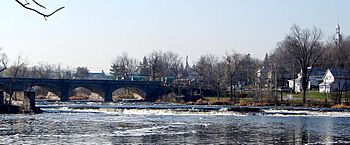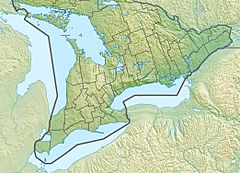Mississippi River (Ontario) facts for kids
Quick facts for kids Mississippi River |
|
|---|---|

Mississippi River with 5-arch stone bridge at Pakenham
|
|
|
Location of the river mouth in southern Ontario
|
|
| Country | Canada |
| Province | Ontario |
| Physical characteristics | |
| Main source | Mackavoy Lake Effingham Township, Addington Highlands, Lennox and Addington County 269 m (883 ft) |
| River mouth | Lac des Chats on the Ottawa River Ottawa 71 m (233 ft) 45°26′29″N 76°17′07″W / 45.44139°N 76.28528°W |
| Length | 200 km (120 mi) |
| Basin features | |
| Progression | Ottawa River→ Saint Lawrence River→ Gulf of Saint Lawrence |
| River system | Ottawa River drainage basin |
| Basin size | 4,450 km2 (1,720 sq mi) |
The Mississippi River is a river in Eastern Ontario, Canada. It flows into the Ottawa River. This river is about 200 kilometres (120 mi) long. It starts at Mackavoy Lake and ends near Fitzroy Harbour.
It has a large drainage basin (the area of land where all water drains into the river) of 4,450 square kilometres (1,720 sq mi). On average, about 40 cubic metres per second (1,400 cu ft/s) of water flows through it. There are more than 250 lakes in this river system.
It's important to know that this Mississippi River is not the same as the much larger Mississippi River in the United States. They are completely different rivers!
Communities along this river include Lanark, Carleton Place, Mississippi Mills (which includes Almonte and Pakenham), and Galetta.
Contents
What's in a Name? The Mississippi River's Origin
The name of the Mississippi River in Canada is a bit of a puzzle. While its spelling looks like the famous American river, it's not related. The American river's name means 'great water', which wouldn't make sense for this smaller Canadian river.
Instead, the name might come from an old Indigenous word, "Mazinaa[bikinigan]-ziibi". This means '[painted] image river'. It could refer to pictographs (ancient rock paintings) found near Mazinaw Lake. However, this idea is not fully proven.
Journey of the River: From Source to Mouth
From where it begins at Mackavoy Lake to where it joins the Ottawa River, the Mississippi River drops about 200 metres (660 ft) in height. This change in elevation creates different landscapes along its path.
River's Path Through Different Rocks
The river starts in an area called the Canadian Shield. Here, the land is made mostly of very old rocks like gneiss and marble. After passing Carleton Place, the river flows through younger areas. These areas have limestone and clay plains. At Carleton Place, you can see rapids and limestone cliffs.
Forests and Trees Along the River
The upper parts of the river basin are covered by temperate deciduous forests. These forests have trees like sugar maple, American beech, and red oak. Long ago, there were many eastern hemlock trees, but most were cut down for their bark. Today, large hemlock stands are rare. Most of the forests you see now are less than a century old.
Ancient Mountains and Modern Plains
The bumpy land in the upper river area comes from very old mountains. These were the Grenville Mountains, which formed over a billion years ago. Over time, these mountains have worn down into hills of gneiss and marble. Further down the river, you'll find younger limestone rocks. Much of this limestone is covered by clay. This clay was left behind when the area was covered by the Champlain Sea a long time ago.
Wetlands and Wildlife Habitats
The Mississippi River has many important natural areas, especially wetlands. Wetlands are areas where water covers the soil, or is present near the surface, for all or parts of the year.
Important Wetlands Along the River
One of the biggest wetlands is the Innisville Wetlands. It's so important that it's recognized as a provincially significant wetland. Another large wetland is the Appleton Silver Maple Swamp. These wetlands need the river's changing water levels to stay healthy.
In spring, high water floods large areas, creating marshy lands. As the water slowly goes down, conditions become perfect for swamp forests. This natural cycle of high and low water helps create a wide variety of plants and animals in the wetlands.
Special Plant Communities
Upstream in Lanark County, two parts of the river are known for their unique plants. One area includes Dalhousie Lake and the swampy river section near Sheridans Rapids. This area is called the McCullochs Mud Lake Wetland.
Another interesting section is the rocky, rapid-filled part of the river from Sheridans Rapids to Playfairville. Here, you can find rare plants like Parnassia glauca (Grass-of-parnassus), Platanthera flava (Tubercled Orchid), and Spiranthes lucida (Shining Ladies'-tresses).
Near where the Mississippi River meets the Ottawa River, there are important shorelines and wetlands. The Mississippi Snye, for example, has many water plants growing over marble rock. It's also a place where musk turtles have been seen.
River's Role in Power and Wildlife
In the past, the river's strong flow powered textile mills. Today, it's used to create hydroelectric power. However, these power dams have almost completely stopped American eels from living in the river. Eels used to be a major food source for Indigenous people and for animals like great blue herons and otters.
Other Natural Areas and Rare Species
The river area is home to several other special natural spots. Purdon Conservation Area has Canada's largest natural group of showy lady slipper orchids, with about 16,000 plants! The Carleton Place Hackberry stand and the Innisville Wetlands are also very important, as mentioned earlier.
In drier spots, there are several significant alvars. These are limestone plains with exposed rock and many rare plants. Examples include the Burnt Lands Alvar and the Panmure Alvar.
Turtles of the Mississippi River
The Mississippi River is home to many different kinds of turtles. These include painted turtles, snapping turtles, Blanding's turtles, musk turtles, and map turtles.
Sadly, the Blanding's turtle, musk turtle, and map turtle are considered species at risk. This is likely because their nesting beaches have been damaged by human development and settlement. Protecting these areas is important for the turtles' survival.
Tributaries
- Clyde River
- Indian River
- Fall River
- Bell's Creek



